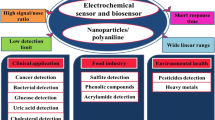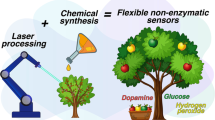Abstract
Human disease processes are often characterized by a deviation from the normal physiological concentration of critical biomarkers. The detection of disease biomarkers requires the development of novel sensing methods which are sensitive, specific, efficient and low-cost. To address this need, the ability of a device, which incorporates a film of polymer acid doped polyaniline, to respond to proteins at physiological pH and ionic strength was assessed. The conductive polymer was found to respond by changing conductivity in the presence of biomolecules, demonstrating a direct chemical to electronic transduction method. In future work, specificity can be incorporated into the system by integrating the conductive polymer with a protein selective film. The demonstration of a conductive polymer which is responsive to proteins at physiological conditions is a step towards the integration of these materials into implantable sensing systems.









Similar content being viewed by others
Abbreviations
- PANI:
-
polyaniline
- PAAMPSA:
-
poly(2-acrylamido-2-methylpropanesulfonic acid)
- Lys:
-
lysozyme
- BSA:
-
bovine serum albumin
- APTS:
-
aminopropyltrimethoxysilane
- APS:
-
ammonium persulfate
- PBS:
-
phosphate buffered solution
- NaCl:
-
sodium chloride
References
H. Bai, G. Shi, Sensors. (2007). doi:10.3390/s7030267
C.L. Bayer, I.J. Trenchard, N.A. Peppas, J. Biomater. Sci., Polym. Ed., in press
D.G. Buerk, Biosensors, Theory and Applications (Technomic, Lancaster, 1993)
J.-C. Chiang, A.G. MacDiarmid, Synth. Met. (1986). doi:10.1016/0379-6779(86)90070-6
B. Deore, Z. Chen, T. Nagaoka, Anal. Sci. (1999). doi:10.2116/analsci.15.827
A.J. Dominis, G.M. Spinks, L.A.P. Kane-Maguire, G.G. Wallace, Synth. Met. (2002). doi:10.1016/S0379-6779(02)00048-6
A.J. Heeger, Rev. Mod. Phys. (2001). doi:10.1103/RevModPhys.73.681
M. Irimia-Vladu, J.W. Fergus, Synth. Met. (2006). doi:10.1016/j.synthmet.2006.11.004
J. Janata, M. Josowicz, Nat Mater. (2003). doi:10.1038/nmat768
E.T. Kang, K.G. Neoh, K.L. Tan, Prog. Polym. Sci. (1998). doi:10.1016/S0079-6700(97)00030-0
D. Kriz, L.I. Andersson, M. Khayyami, B. Danielsson, P. Larsson, K. Mosbach, Biomimetics 3, 2 (1995)
U. Lange, N.V. Roznyatovskaya, V.M. Mirsky, Anal. Chim. Acta. (2008). doi:10.1016/j.aca.2008.02.068
K.S. Lee, G.B. Blanchet, F. Gao, Y.-L. Loo, Appl. Phys. Lett. (2005). doi:10.1063/1.1862345
K.S. Lee, T.J. Smith, K.C. Dickey, J.E. Yoo, K.J. Stevenson, Y.L. Loo, Adv. Funct. Mater. (2006). doi:10.1002/adfm.200600170
A.G. MacDiarmid, A.J. Epstein, Faraday Discuss. (1989). doi:10.1039/DC9898800317
A.G. MacDiarmid, A.J. Epstein, Synth. Met. (1995). doi:10.1016/0379-6779(94)02374-8
A.G. MacDiarmid, Synth. Met. (1997). doi:10.1016/S0379-6779(97)80658-3
A. Malinauskas, Polymer (2001). doi:10.1016/S0032-3861(00)00800-4
N. Mano, J.E. Yoo, J. Tarver, Y.L. Loo, A. Heller, J. Am. Chem. Soc. (2007). doi:10.1021/ja071946c
P.M. McManus, R.J. Cushman, S.C. Yang, J. Phys. Chem. (1987). doi:10.1021/j100287a050
H.S. Moon, J.K. Park, Synth. Met. (1998). doi:10.1016/S0379-6779(98)80090-8
E.P. Plueddemann, Silane Coupling Agents (Plenum, New York, 1991)
G.K. Prasad, T.P. Radhakrishnan, D.S. Kumar, M.G. Krishna, Sens. Actuators, B, Chem. (2005). doi:10.1016/j.snb.2004.09.011
A. Ramanaviciene, A. Ramanavicius, Anal. Bioanal. Chem. (2004). doi:10.1007/s00216-004-2573-6
L. Sun, H. Liu, R. Clark, S.C. Yang, Synth. Met. (1997). doi:10.1016/S0379-6779(96)03839-8
J. Tarver, J.E. Yoo, T.J. Dennes, J. Schwartz, Y.L. Loo, Chem. Mater. (2009). doi:10.1021/cm802314h
S. Virji, R.B. Kaner, B.H. Weiller, J. Phys. Chem. B. (2006). doi:10.1021/jp063166g
J. Wang, Chem.-Eur. J. (1999). doi:10.1002/(SICI)1521-3765(19990604)5:6<1681::AID-CHEM1681>3.0.CO;2-U
J. Wang, M. Jiang, Langmuir (2000). doi:10.1021/la991122b
J.G. Webster, Electrical Measurement, Signal Processing, and Displays (CRC, Boca Raton, 2004)
Y.N. Xia, J.M. Wiesinger, A.G. Macdiarmid, A.J. Epstein, Chem. Mater. (1995). doi:10.1021/cm00051a002
D. Yang, P.N. Adams, L. Brown, B.R. Mattes, Synth. Met. (2006). doi:10.1016/j.synthmet.2006.09.002
J.E. Yoo, T.L. Bucholz, S.Y. Jung, Y.L. Loo, J. Mater. Chem. (2008). doi:10.1039/b802829j
J.E. Yoo, J.L. Cross, T.L. Bucholz, K.S. Lee, M.P. Espe, Y.-L. Loo, J Mater Chem. (2007). doi:10.1039/b618521e
W. Zheng, Y. Min, A.G. MacDiarmid, M. Angelopoulos, Y.H. Liao, A.J. Epstein, Synth. Met. (1997). doi:10.1016/S0379-6779(97)80669-8
Acknowledgements
The authors thank Dr. Yueh-Lin Loo for discussions on the PANI-PAAMPSA materials. This work was funded in part by a National Science Foundation Integrative Graduate Education and Research Traineeship (IGERT) Fellowship (to C.L.B.) DGE-03-33080.
Author information
Authors and Affiliations
Corresponding author
Rights and permissions
About this article
Cite this article
Bayer, C.L., Konuk, A.A. & Peppas, N.A. Development of a protein sensing device utilizing interactions between polyaniline and a polymer acid dopant. Biomed Microdevices 12, 435–442 (2010). https://doi.org/10.1007/s10544-010-9400-y
Published:
Issue Date:
DOI: https://doi.org/10.1007/s10544-010-9400-y




